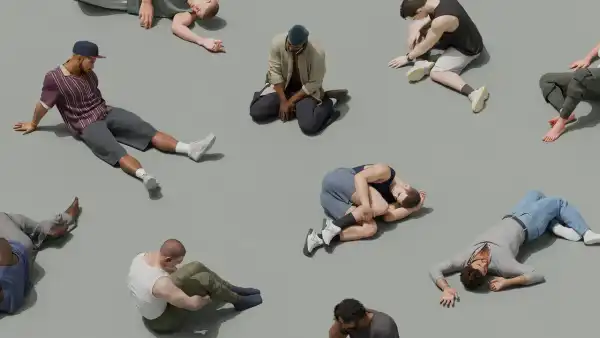
Save this storySave this storySave this storySave this story
The muscled, white, and shaven-headed Scott Galloway resembles a toy figure from the tech-and-finance elite. He’s an early-stage investor, a celebrated author, and a financial-planning expert. He frequently creates podcasts: he’s the main voice of “The Prof G Pod,” which presents observations on business and career guidance; “Pivot,” where he banters about current affairs with tech reporter Kara Swisher; and the bluntly titled “Raging Moderates,” with Fox News contributor Jessica Tarlov. For a denizen of this elite class, he’s notably forward-thinking and aware of his privileges; he readily admits that his affluence and successes were made more attainable thanks to his ethnicity, gender, publicly funded schooling, and committed mother, who was mostly his only caretaker.
In recent times, Galloway has emerged as a key spokesperson for a concept that quickly turned into accepted wisdom: young American males are facing hardship. “Rarely in recent times has a generation experienced a more precipitous decline,” he states in his latest publication, “Notes on Being a Man.” To substantiate his point, Galloway utilizes a widely disseminated array of statistical data. Across colleges and universities nationwide, female enrollees substantially surpass their male counterparts, often by a margin of two to three. Within the young-adult demographic, men are more inclined to reside with their parents; by their mid-thirties, over fifteen per cent of men remain in their childhood homes, compared to fewer than nine per cent of women. The male suicide rate is about three and a half times higher than that of women. Men’s inflation-adjusted earnings are lower for both low and mid-level income earners than in 1979. At present, the rate of unemployment among young men with bachelor’s degrees between twenty-three and thirty is approximately twice that of their female counterparts.
These figures have prompted bipartisan worry. This past March, California’s Governor Gavin Newsom, during the initial airing of his fresh podcast, hosted conservative figure Charlie Kirk, who decried Generation Z as the “most alcohol-dependent, most drug-dependent, most suicidal, most depressed, most medicated generation in history.” And these individuals in their twenties, Kirk noted, were being given a destructive idea: “You’re not going to experience the same American Dream that your parents did.” He and his fellow conservative organizers “saw this as an opportunity,” he continued, “particularly with young men.” In the 2024 election, Donald Trump secured fifty-six per cent of the votes from men under thirty, an increase of fifteen percentage points from 2020. Kirk attributed these advancements to the mounting electoral force of the right-leaning collective of podcasters and streamers known as the manosphere, including libertarian bros, evangelical Christians, and white nationalists.
Newsom, with aspirations of becoming the next Democratic Presidential candidate, seemed to be carefully considering this. At the close of July, he enacted an executive decree aimed at “addressing California’s increasing issue of disconnection and opportunity for men and boys.” A week later, another potential Democratic contender, former Chicago mayor Rahm Emanuel, penned an opinion piece in the Washington Post, linking unaffordable housing and health care to an “increasingly disheartened” sentiment among young men. “You don’t need to be an incel to feel that the ‘system’ is inherently flawed and stacked against your success,” Emanuel wrote.
Like Newsom, Emanuel is engaging in a maneuver that certain Democrats excel at: triangulation. Both politicians have taken Kirk’s proposition at face value—that young American men are in a dire and unprecedented situation, steering them toward right-wing ideologies—yet they seek to redirect the discourse away from inflammatory language and misogynistic slogans, toward a balanced approach characterized by respectful dialogue and technical solutions. Emanuel suggests remedies for young-male discontent in the form of updated zoning ordinances and tax breaks for first-time home buyers. (This kind of stuff is very popular with the audiences of Theo Von and Barstool.) However, Emanuel does not see comparable promise in New York City’s incoming mayor, the Democratic Socialist Zohran Mamdani, even though Mamdani’s campaign heavily emphasized affordability, and early exit surveys indicated that he garnered an impressive forty-point lead among male voters between eighteen and twenty-nine. When Emanuel voiced his criticism of Mamdani’s explicitly leftist platform in a letter to the Wall Street Journal, it was titled “My Party’s Future Isn’t Mamdani’s New York.”
It appears that some Democrats would prefer their own version of a centrist manosphere. (Picture a podcasting studio connected to a top-tier gym where several white men deliberate on “Abundance” while sipping beta-alanine smoothies and performing pistol squats to the theme song of “Pod Save America.”) In “Notes on Being a Man,” Galloway—who has voiced optimism about the Presidential chances of both Newsom and Emanuel—argues that disenchanted members of Gen Z and the boys and teens of Gen Alpha require an “inspirational vision of masculinity,” one that opposes the misogynistic messages promoted by figures like Andrew Tate and Nick Fuentes. The book, which is partly a self-help memoir and partly a pro-men rant, lays out a fundamental tenet: “Men Protect, Provide, and Procreate.” Masculinity, as Galloway once put it, can be expressed simply by “getting up at fucking six in the morning and going to work and doing shitty work such that you can protect your family economically.” Furthermore, the evolved man ensures that he does not fall short “domestically, emotionally, or logistically,” leaving his partner to ask, in Galloway’s uniquely colloquial manner, “O.K., boss, what the fuck are you bringing to the table?”
The virtuous man of the reasonable center, according to Galloway, adheres to a code similar to that of the Boy Scouts: being mentally and physically fit, emotionally strong, industrious, financially responsible, and considerate of others. Few could disagree with these ideals. Yet the individual described—a thoughtful and caring person who strives for a decent income and supports their loved ones—appears remarkably gender-neutral. So, why make this specifically about men? Even the Boy Scouts are now coed.
 Illustration by Max Guther
Illustration by Max Guther
There’s no doubt that the long-term decline of the U.S. manufacturing sector, along with the associated erosion of unionized jobs with benefits, has disproportionately impacted working-class men. (This might particularly affect Black men, whose access to these stable, well-compensated jobs significantly increased after the victories of the civil-rights era.) The continuous collapse of industry has influenced many of the statistics crucial to discussions about the male predicament. However, by slightly altering some of the most commonly cited data, one could just as convincingly argue for a female predicament or, more accurately, an ongoing multi-faceted challenge that affects us all.
For instance, the gender disparity in college admissions could indicate a disoriented, unmotivated generation of young men, but it could also stem from varying economic motivators. A study released last year by Georgetown University’s Center on Education and the Workforce examined rural America’s job market, noting that women require more education to earn as much as men and that the less education a worker has, the more pronounced this gender gap becomes. The broader trend for the lowest-earning men is certainly not promising, but it’s unclear if their female counterparts are faring significantly better.
As another instance, the difference between male and female suicide rates is actually decreasing—it was previously five to one in 2007—and young women attempt suicide more often than young men. Women’s overall earnings are still seventeen per cent less than men’s, partly because women are excessively represented in many relatively low-paying areas of health care and social services. This same imbalance also helps explain the unemployment gap between younger men and women: health care provides most of the labor-force growth in the U.S., and women are taking most of these positions. Nevertheless, unemployment among Black women is on the rise, partially due to their overrepresentation in federal agencies that were reduced by DOGE, and labor-force participation among women with children is declining, likely due to growing child-care costs and the strict return-to-office policies supported by the Trump Administration.
One of the more practical suggestions arising from discussions about the male hardship is that the U.S. should launch a campaign to encourage more young men to pursue HEAL careers. (The acronym encompasses Health, Education, Administration, and Literacy.) Teaching and nursing are grappling with significant workforce deficits; these roles may not offer lavish salaries and can be demanding, but they are also resistant to automation and relatively secure during economic downturns. In the widely read critique “Of Boys and Men” (2022), the social scientist Richard V. Reeves writes, “We need to break the cycle of professions taught by women for women. Some robust affirmative action is justified here.” The economist and former Times columnist Paul Krugman has recently echoed Reeves’s sentiment, writing on his Substack, “Many of these occupations are female-coded and have become more so over time, partly because they’re underpaid. But they don’t have to be . . . we can help attract men into these occupations in part by increasing the wages HEAL occupations pay.”
It should be noted that women have predominated in teaching since the nineteenth century not because of a misandrist employment conspiracy, but because early public-education advocates realized they could expand the school system faster by employing women teachers, who could be paid less than men. One might question whether challenging, vital work should be adequately compensated, regardless of an individual’s gender. However, much of the centrist manosphere’s discourse relies on ignoring half of the situation. Newsom’s executive order concerning men and boys acknowledges the strong connection between social-media use and mental-health issues like depression and anxiety, but neglects to mention that these effects are significantly more pronounced in girls. In “Notes on Being a Man,” Galloway writes, “The deliberate transfer of wealth from the young to the old in the United States over the past century has led to unaffordable and indefensible costs for education and housing, and skyrocketing student debt, all of which directly affect young men.” He could have said “young people,” unless college bursars and landlords have a ladies-only discount program that I haven’t heard of.
Emanuel, in his Washington Post op-ed, frankly promotes a double standard. He writes that the expense of housing “is, of course, a problem for all Americans—men and women alike. But, unpopular as it might be to say in some quarters of my party, the crisis affects one gender with particular potency.” In essence, men and women pay the same amount, but we are expected to accept that men bear a greater social and emotional cost. (If women seek their own crisis, it might be that they are not giving birth to enough children.)
The representatives of the centrist manosphere commend women’s progress and the feminist cause while asserting that men’s anxieties about economics and careers are inherently more intense. This contradiction exposes their position’s fragility. The right-wing manosphere understands that masculinity is a series of displays of dominance conveyed through reflective sunglasses and behind the wheel of an enormous pickup truck; it is a sneering millionaire who “DESTROYS” a young woman at a college discussion; it is—need it be said?—an openly carried AR-15. According to Susan Faludi, manliness in the Trump era “is defined by display value,” which expresses itself in a “pantomime of aggrieved aggression.” On this stage, men’s biggest challenge is feminism, and the solutions are simple: restrict abortion rights, promote conventional gender roles, and so on.
The more moderate centrist perspective lacks such certainties. Galloway, in both his podcasts and “Notes on Being a Man,” depicts masculinity not as one part of a fixed duality but as a frame of mind and a lifestyle, equally attainable by both men and women, making it impossible to define. (It’s a feeling, and we know how Trump’s followers feel about those.) Within this fluid structure, men’s primary problem is similarly a feeling—a persistent irritation, or a deeply held belief—that men should still occupy a higher position than women in society, albeit to a lesser degree than before. This belief might be misguided or unconscious, yet it is insurmountable and must be accommodated for the collective good.
These commentators are, in essence, gently prompting us to accept that women are generally accustomed to being somewhat undervalued, underpaid, overlooked, and restrained in their ambitions, in ways that men are not and never will be. The “female-coded” individual, to use Krugman’s phrase, may feel overwhelmed by child-care expenses, embarrassed by their inability to secure a mortgage, or depleted by lengthy shifts as an I.C.U. nurse, but these sentiments do not disrupt the universal order. This individual’s duties to protect, provide, and procreate are tangible, but they are not prioritized. This individual’s views matter, but not definitively. The Times commentator Ezra Klein has recently proposed that Democrats consider fielding anti-abortion candidates in red states, even though over three-quarters of Gen Z women support abortion rights. Like jobs, rights can be gender-coded, and are valued accordingly.
“You need Dad,” Galloway, a father of two sons, stated on a recent podcast. The traditional family structure he describes seems to place the mother as the primary caregiver (“They look to her for nurturing. When they really have a problem, I find they go to Mom”), while the necessary dad is the authority figure to whom Mom can appeal when required. “There are certain moments when my partner needs me to weigh in,” Galloway explained. “I don’t know if it’s the depth of my voice, my physical size.” He added that boys “begin tuning out their mom over time.” One might question how boys lose these frequencies in the first place. One might wish for a deep voice to explain it.
In “Of Boys and Men,” Reeves, a scholar at the Brookings Institution, draws on the work of the late British sociologist Geoff Dench, who suggested that the “fundamental weakness of feminist analysis” is its failure “to see that men may need the status of the main provider role to give them a sufficient reason to become fully involved, and stay involved, in the longer-term draggy business of family life.” Reeves also supports the supply-side economist George Gilder’s theory that, when wives become “both provider and procreator,” their husbands become “exiles” in their own households. While Reeves generally rejects Gilder and Dench’s revanchist views on patriarchy, he acknowledges their accurate diagnosis of “the dangers of anomie and detachment among men stripped of their traditional role.” Reeves has noted that, in an era where two out of every five households have a female primary breadwinner, no one seems to know “what fathers are for.” One in six fathers does not reside with any of his children. One study revealed that thirty-two per cent of non-resident fathers had minimal contact with their children within one year of separating from the children’s mother, and that this figure increased to fifty-five per cent within eight years.
Reeves is concerned that homes without fathers will lead to more troubled boys, more men in their twenties living at home, and more fractured families. He cautions that, unless we update our “obsolete model of the breadwinner father,” “we will continue to see more and more men being left out of family life.” Reeves never identifies the authority that has determined these absent fathers should be “left out” of their own families; the identity of the culprit remains obscure. Nor does Reeves explain how women’s economic independence would cause their husbands to be “stripped” of anything, least of all the non-economic elements of being a spouse or parent.
The idea that fathers abandon their families due to some lingering sense of existential unease—a humiliating conviction of their own inadequacy or displacement—is especially striking when one considers the significant gender disparity in housework and child-rearing within heterosexual marriages. According to the Gender Equity Policy Institute, mothers who work full-time perform nearly twice as much household labor as fathers. Research from Nobel-winning economist Claudia Goldin indicates that married men’s reluctance toward housework and other “draggy business of family life” may be impeding birth rates, which should interest Republican pronatalists such as J. D. Vance.
As one delves deeper into the nation’s supposed problem of men and boys, and its potential solutions, the female reader may develop a sentiment stronger than simple resentment or intellectual disdain. She might instead feel a chauvinistic gratitude in her gender. The familiar sense of being somewhat undervalued might seem preferable to the anger, entitlement, and alienation that (we are continually told) eats away at so many male individuals. What a gift it is, truly, to have no choice in the matter. To be compelled to leave your parents’ house, to arrive at your job, to change the diaper, not because it’s affirming to your gender identity, but because life presents tasks that require completion, and you are the one to complete them. At least then you know who you are.
Reading Galloway, one gets the impression that men last had a firm sense of identity about seventy-five years ago. Much like the Trump Administration does when it pledges to revitalize the coal sector, or when it shares fascist-inspired imagery suitable for a Paul Verhoeven film, Galloway taps into the reader’s longing for mid-century “Peak Male.” He reminds us that it was young men who stormed the beaches of Normandy and triumphed at the Battle of the Bulge: “When Germans or Russians are streaming over the border or firing from the beach, big-dick energy isn’t just a nice idea; it’s fucking mandatory.” Of course, the German soldiers were also young men. And it remains unclear which border Galloway thinks the Russians were crossing, or whether he understands which side they were on.
Galloway also highlights two significant building projects of the Great Depression as past proof of men’s capacity for “collective effort, incredible bravery, risk-taking, aggression, and sacrifice.” One was the construction of the Hoover Dam, during which, Galloway notes, numerous workers succumbed to heat exhaustion or carbon-monoxide poisoning. The other was the Empire State Building. “Construction began in 1930 and ended a year later, under budget and ahead of schedule,” Galloway approvingly states. He omits that the skyscraper was built so rapidly and affordably in part because New York City was filled with men willing to work for meager wages under severe, even dangerous conditions, due to the global economic collapse that had suppressed wages and unions. Perhaps these harsh conditions only intensify the men’s heroism.
Coincidentally, “Notes on Being a Man” is being released in the same month as Glenn Kurtz’s “Men at Work: The Empire State Building and the Untold Story of the Craftsmen Who Built It,” which adds personal details and insights to Lewis Hine’s iconic photos of the skyscraper’s construction. The identities of most of these workers are unknown, partly because they were regarded not as men but as “hands,” Kurtz writes—as “something less than complete people,” or, at best, as “embodiments of generalities and abstract ideals,” such as those found in Galloway’s book. For all we know, these men may have felt that the system “was fundamentally broken and rigged against” them as well. Yet they are long deceased and largely unidentified, and thus can be whatever we want them to be.
Kurtz uncovers what he can about their lives, revealing ample proof of what we might now term men in crisis: deaths from despair, displacement and dysfunctional families, dependency. A thirty-year-old carpenter named Finn Egeland either jumped or fell from the Empire State Building as construction neared completion; his death was ruled a suicide. Another carpenter, Matthew McKean, had abandoned his wife and two children in Scotland. And a stonemason in his twenties named James Kerr was still living with his mother. ♦
Sourse: newyorker.com







